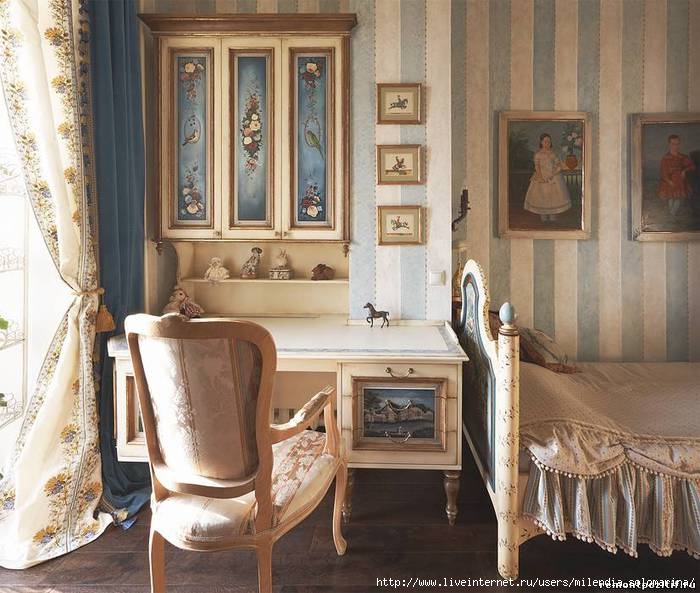Cabinet in Russian style. Interior in Russian style. Natural materials are the secret of the comfort of Russian cuisine
The philosophy of the Noble style in modern interiors is focused on creating a comfortable, cozy and measured atmosphere of housing, where life is leisurely, funny and pleasant.
In pre-revolutionary times in Russia, the Provence and Chebbi-Chic styles were not even suspected, but in the days of Pushkin, the style was popular in noble estates. This practical style perfectly fit into the interiors of the houses of nobles, landowners and royal dachas, and became a prime example for solving a laconic and elegant interior ..
Add something old and new, modern and contemporary, furniture from the mid-twentieth century and Scandinavian design equal to personality and authenticity. Designed for a young couple and with an area of \u200b\u200bjust over one hundred square meters, it is quite open house with lots of natural light, unique angles and a separate area from the rest.
The main element that distinguishes the dining-kitchen is the open plywood box. It is about expanding and closing the balcony that was originally in this new building. The integration of the balcony and, in short, the creation of this box made it possible to enlarge the window, which was necessary to ensure that natural light bathed the rest of the stay.

Creating the style of the Noble Manor in your interior, it is enough to go to the flea market or rummage in the grandfather's attic. The found thing, which still served the ancestors, does not even have to be specially aged. The good thing about modern shibby chic is the ability to go well with both Russian Biedermeier and French Provence.
Russian chambers in a city apartment
The dining room is in a box. Its open structure makes this area still part of the main room and at the same time has a certain independence from the rest. The same goes for the home office. It is in the living room, but hidden between two shelves to the ceiling, creating a kind of cube in which they placed the table and work equipment.
As we said at the beginning, combination is the key in this apartment. The kitchen is the best example. This is the most technologically advanced area of \u200b\u200bthe house, with a warmer style. But it doesn't stand out thanks to the minimalist approach the studio has taken in interior design.


Painting by Stanislav Zhukovsky ("the singer of an old Russian estate")
Biedermeier (/www.liveinternet.ru/users/milendia_solomarina/post216154944"\u003e CM. Article HERE) abolished the pathos of the Empire style and gave preference to soft and round shapes, while maintaining, with all this, the main principles of construction and brevity. The main aspects were strength, accuracy , good quality, convenience and a certain intimacy Balance of proportions and measured tones, minimum decor and maximum simplicity - mental comfort and material well-being. 
The mixture is very present in the chromatic palette. Part of a neutral base, but with accents of color that add personality to every room, be it bright or pastel shades. The latter is visible in the general area. White walls and wood in light tones blend with pearl gray, soft blue and coral to create a cozy atmosphere.
In the bedroom, half of the wall has been painted with a more intense blue, and the details have been chosen in red to achieve a more dramatic effect in the relaxed line that prevails throughout the house. When it comes to materials, there are many varieties, but they are always looking for a warm environment. Open brick wall the living room is accompanied by plaster walls, all made of white. The wood floors are carpeted in harmony with the fabrics chosen for the sofa and the rest of the living rooms.
The style of the Noble Manor is the interior of a house with a long "pedigree" that carefully preserves objects dear to the heart in a fairly shabby state, displays them and even takes pride in them, which allows you to combine your favorite antique furniture with new artfully aged things. This style creates an atmosphere of a large and friendly family, where conservative traditions are respected, where all generations live in harmony and love for each other.
It was founded by architects and designers Alexander Malinin and Anastasia Sheveleva, and photographers, artists and even philosophers are part of the team. His philosophy behind redundancy, the answers lie between the rational and the irrational. His scope of work is varied: interiors of houses and public and private premises, landscaping, industrial design and urban planning.
The first mention of Russian national cuisine dates back to the century. Its author is the historian, astronomer and Arab geographer Ibn Rust. East Slavs, according to Rust, they ate exclusively on mare's milk. At the height of the Cold War, the famous European culinary publication indicated that the Russian soup "okrochka" was made from a mixture of beer and vodka, and Russian borscht was necessarily served rotten at the table.

Here, for example, interesting project Children's room designed in the style of the first Russian noble estate half of XIX century.

The basis of the interior is a real antique Nun wardrobe of the 19th century. Artists painted it using the style and urban views of the first half of the nineteenth century. The result is a "Pushkin-Onegisky" plot.
Obviously, the floor, ceiling and walls of the room should be combined with the furniture of Russian classicism. The floor was laid out with a specially treated, embossed, oak floorboard. The walls were painted with wallpaper.
Natural materials are the secret of the comfort of Russian cuisine
The Iron Curtain has collapsed and revealed to the world another image of Russian cuisine, mountains of black caviar, without which a "Russian-style" dinner was not held. The cooks who left Russia for Europe or America were trying to show not the real Russian cuisine, but the one expected from them by foreigners who learned about this distant, snow-covered country through the film "Doctor Jivago".
Some of the characteristics of real Russian cuisine were given in the Russkaya Gazeta. The strong Russian climate does not help agriculture for most of the year. But, on the contrary, Russia has always had enough forest resources. Deciduous forests in the temperate zone and coniferous taiga in the northern region guarantee Russians enough fuel for daily use of the national fireplace regime - the Russian stove.

At the heart of the textured art plaster, very durable and practical. The drawing is applied in gold paint. It turned out spectacularly. Moreover, the decision is in keeping with the spirit of the times. For example, in the Moscow Sheremetyev Palace, the walls are painted to match the wallpaper.
In modern technical language, the Russian stove has a very low efficiency factor, not exceeding 30%. To raise the oven temperature high enough to bake a loaf, you need at least a dozen logs, almost a small tree. However, by heating the oven well, it is possible to cook several dishes that require prolonged heating, and at the same time prepare bread and cakes for a large family.
The other side of tradition
It is this slow cooling - even 8-12 hours after the oven warmed up, the heat inside the oven was retained, which helped the Russians create their own national cuisine. Cabbage soup and boiled cereals. Among them, over the centuries, the most popular and valuable were the many types of soups and cooked and hot cereals, the preferences of many families today. The traditional meal of the peasant family was a bowl of soup and a bowl of well-prepared and healthy cereals, which could be buckwheat, corn, rye, or ordinary wheat.



An interesting move was the large and roomy built-in wardrobe from floor to ceiling. Seemingly, modern technology... However, thanks to the overhead elements: cornice, pylons, heels, frieze - visually it is perceived as a free-standing one, the feeling of a built-in wardrobe disappears. That's what it is good for.
Traditional pickling of vegetables and mushrooms using natural lactic acid fermentation, also called "pickling", is important part Russian cuisine. And the pickle left over from canned cabbage and cucumbers once played the same role as soy sauce in Southeast Asia.
Restorations and alterations - the secret of uniqueness and cost savings
From the reserves, in addition to soups, so-called "pickle dishes", "solchanka", "pickles", "potassium" are also prepared. One of the medieval travelers, the German scientist Adam Olearius, traveling through Moscow, singled out the "hangover", fried mutton in brine.


Antique baby chairs in Provence style. The style is different, but thanks to the painting, they are very suitable for the interior. The mirror is real, antique, however, rustic, after painting came to life and played in a completely new light.
Among the main products of Russia, we must mention freshwater fish of a wide variety of varieties, which have always been in abundance in the country. And yes, of course, the famous Russian black caviar. Special pies, known only in Russia, are also fried with filling fish - "kulebyaki", "rybniki", "pie".
Pies and other pasta are the hallmark of our cuisine. There are many varieties of fillings, pasta and pies. Open, closed, strings, biscuits, unleavened and sour, sweet and savory, made with brine. The Shrovetide party, held before Lent, does not pass without pancakes.

Large built-in wardrobe, table, cabinet above the table, bed, bookcase -
designed and made in
- Artistic painting of furniture and interior, paintings -

Now let's look at how Chebbi-Chic and Provence are combined with each other:
But "pancakes" are not only prepared at Maslenitsa. After Christmas, the holidays called "Christmastide" are also called "Ovsianitsa" because in some places oat pancakes are prepared. Russia is a multinational country, and its cuisine has peacefully coexisted for centuries with the national gastronomy of other peoples. Some of the dishes that today were considered completely Russian came from our neighbors: small Hungarian "dumplings", Turkish pasta, etc.
In the same way, the popular cuisine of all nationalities inhabiting Russia has been enriched with truly Russian dishes. Unfortunately, in today's Russia, it is difficult to find truly Russian cuisine on restaurant menus. They will probably serve as your imitation - it may be delicious, but far from authentic.
Color is the most important component of any interior style.
Favorite Shabby Chic colors are pastels, from dusty pink to pale olive, ivory, milky white and light blue. If the walls are often white, often roughly painted. Or wallpaper - with a texture that imitates peeling paint, or with a small pattern in a small flower, with angels, roses, but a dim, as if faded color. The ceiling is not pure white, but as if it has lost its whiteness from time to time. You can decorate it with stucco (rosette, moldings) and gilded with gold leaf. The floors are wooden with aging effect.
Most often, real Russian ovens appear in provincial restaurants, and young chefs are not surprised at the "richness" of the dishes, but rather preserve the authenticity of the preparation. Farmers have begun to cultivate almost forgotten red wheat and turnips, and dishes made with these age-old Russian products, made with skillful hands, are made by famous Moscow houses such as the Lavkalavka coffee shop.
All rights reserved in Rossiyskaya Gazeta. The redevelopment of the property was quite billowing. Thanks to its clearly recognizable baroque elements, it is on the list of "Real Cultural Memories", so all drawings are related to the rules for these buildings.

Favorite colors of Provence are warm olive, cream, milky white, lavender, ocher and terracotta. These are light soft shades, pastel colors. There are practically no dark colors in the interior, light facades prevail in the furniture. A Provencal style room should be warm and sunny, filled with air and light. Favorite color combination - yellow with pastel blue, which symbolizes the southern sky and flowering meadows of Provence
A farm that has been a family for centuries
The estate on a hilly hill overlooking the Brandy castle consists of a large residential building, preserved remains of farm buildings, including a barn and a brewery. In the first phase of the work, the two floors of the main building were modified so that they could be linked to other buildings.
This is why the exterior of the building has not changed since the renovation. In terms of history, the paul and the staircase leading to the entrances have been restored. “The construction of the technical building of the building resulted in a general layout of the interior layout, removal of internal planks and the construction of new ceilings and staircases,” says architect Cook, author of the project.

Perfect for Provence-style walls decorative plaster with rough texture - imitation village house... It is allowed to use paper wallpaper with a Provence style print, for example, a small flower. The main thing is to choose the lightest shades, ideally - white. The task is to expand the space as much as possible, fill it with light. For the floor and ceiling, you can try wood paneling.
The original layout with a dominant longitudinal axis has been preserved after reconstruction. The main service station has a staircase and then a "reception" or living room with kitchenette, dressing room, bathroom and bedroom. Living quarters live on the battlefields.
“The reason for the reflection of distinctive and complex details and of the entire space is one of the original motives of the entire renovation, which is reflected both in the future and in the bathrooms,” says Teresa Cook. In light colors, the interior design has its own ambiance to evoke the warmth of the home. Therefore, the architect Kukb used lightly colored soft wool, which was only impregnated and left without coating. The floors of the living quarters are light from stool oak, on the other hand, the central road has a black glass plate.

For the floor, a parquet board with a rough wooden texture, or painted in brick and light brown shades, is suitable. Self-woven runners, rugs and rustic rugs are a great addition.
The ceiling must be necessarily light, the use of newfangled materials and technologies is unacceptable. A wrought iron chandelier will become a bright accent in a Provence style children's room, and as an addition - wall lamps and sconces with hand-forged elements.
The massive concrete structure of the lobby staircase is devoid of the light oak wood that allows light to enter the patio. The door cassette was finished in a slightly white lacquer. In the glazed volumes, architect Cook used an original patterned pattern of delicate colors.
Light oak bedding will allow light to enter the dark room at the intersection. The new kitchen utensils used in the bathrooms were in the middle so they could stay clad free and breathe. The price porch between the hallway and the bathroom has been fashionably restored.

When choosing Provence - textiles, we give preference to natural fabrics without shine - silk, cotton, chintz, bleached linen. The fabrics are either plain or with embroidery or small floral patterns. Embroidery, in general, is very characteristic of the Provencal style. Plant motifs and classic stripes will also perfectly fit into the interior. Paints on fabrics should have a kind of faded color, artificially aged fabrics will look very impressive.
In the bathroom, he emphasizes the importance of reflection in the mirror pole on which the sink is located. The tub was attached to a light-colored glass bow that illuminates the adjacent dressing room at the same time. On the floor, the sink creator has moved in front of the mirror, the bath is again in the center of the arrangement. Bathroom furniture is shiny to reflect the maximum amount of light. The interior of the bathroom, even through a small window, makes a light and pleasant impression. New riddles of the distinctive note in the room were solved with furniture, so a lot of space was contained.

Variegated pastel upholstery of upholstered furniture, curtains and colorful covers in light colors are the hallmarks of Shabby chic textiles.

In a Shabby Chic style, painted and worn furniture should show the underlying layers and signs of age. Often it is decorated with paintings - roses or angels. Upholstered furniture is covered with covers with flounces, covers for chairs, armchairs and sofas are rough and deliberately rumpled. In the bedroom there is always an old bed with metal headboards. As decorative accessories, shabby chic welcomes antiques of all kinds. 
As we can see, the English style of shabby chic not only goes well with the styles of the Russian Noble Estate and French Provence, it seems to be created in order to emphasize these older styles.
Dare, knowing the theory, it is much easier to create interiors! @Milendia
The Russian style has become a fashionable trend outside our homeland more than once - it was only necessary for Russia to somehow save or shake the world. But what comes to mind of a foreigner if the conversation comes to our life? Of course, a log tower in a dense forest, and in it - nesting dolls and samovars, popular prints and spinning wheels, bast shoes and khokhloma. Few are aware of the striking differences between the appearance of a noble estate and a village hut, and even the Russians themselves, having decided to revive traditions at least in their own home, sometimes have the most superficial idea of \u200b\u200bthe interior "in Russian". The result, however, literally hurts the eye: an apartment or a cottage turns into an absurd semblance of a provincial museum displaying items of peasant life.
In fact, a truly Russian interior should not be associated exclusively with applied folk art or, worse, with rough benches instead of comfortable chairs. Everything is much more complicated, and it is not without reason that there are long disputes among artists and designers about directions and nuances. The Russian style in interior design has once again ascended almost to the peak of fashion - and is interesting already because it is able to organically combine modernity and antiquity.
Features of the Russian style
Floor, walls and ceilingsNatural wood, of course! Logs on the ceiling and walls or finishing with a special board with an aging effect. Wall painting is possible - bright ornament, patterns with motives of herbs or flowers. The floor is massive, made of thick blocks, in some versions - parquet or mosaic stone, but no linoleum or laminate. When choosing "royal chambers" the ceilings are made vaulted.
Doors and windowsPlastic in Russian design is simply unacceptable - or is carefully masked. Glass mosaics are sometimes used in interior doors, but the frames are always wooden. Lancet windows with metal bindings look great. Swinging patterned shutters are required, and curtains made of linen or lace, embroidered by hand.
LightingThe houses of our ancestors were lit by lamps and candles. And the Russian style of the interior requires lamps of just such shapes. For more luxurious style modifications, lamps with sophisticated shades are needed. Imitation lanterns and wrought-iron candlesticks look great.
Russian stovePerhaps the main attribute of the style is, of course, a stove or a fireplace depicting it. The stove is faced with tiles - tiles with a convex pattern or glazed.
FurnishingsAnd again a tree, best of all - pine, ash or oak. The chairs have been replaced with benches along the walls, but the benches can be made in the form of very elegant carved "sofas". Massive tables and beds (sometimes wrought iron). Cabinets in Russian villages began to appear only in the middle of the 19th century, and therefore in the interior they are replaced by chests - and such a chest can be a real work of art.
AccessoriesThe Russian style in the interior is, first of all, lace and wood carving. Also required are bright patterns, paintings on tableware, homespun textiles and all kinds of "antique" items (especially antiques). In the "Empire" version, there is certainly a fair amount of gilded decor, an abundance of stucco, arches, and bas-reliefs of biblical and mythological themes.
Nuances of directions
The simplest and most famous trend is "a la rus", a purely ethnic style. It mainly features accessories, accents that give a colorful and non-trivial look even to a house with a standard modern interior... Yes, the image will be characterized by some primitivism, but it will be smoothed out by an indisputable spirituality. At the same time, it is very easy to settle the "Russian spirit" in an ordinary apartment.
Another very common interior design in the Russian style is called "Russian hut" - this is how they usually decorate country houses and cottages. The central room in the Russian hut, of course, is the upper room. A front corner is required here (with icons if desired), a large table in the middle of the room. The key place is given to the oven. In the bedroom there is a bed with a mountain of featherbeds, pillows, down or patchwork quilts.
Without a doubt, the Russian way of life is simple and practical, but the nobles never denied luxury and could well decorate the estate with wallpaper, or even fabrics on the walls, stained glass windows, brocaded sofas. The "noble nest" style also allows for "foreign" objects - graceful (but wooden!) Figurines, Persian carpets, deep and soft armchairs.
Close to the "noble nest" is the style of the "royal chambers", also called "terem" and "fabulous version". And this is truly a fairy tale - a spacious house with carved wooden columns. In a tsar's tale, pictures are quite appropriate - but certainly Russian landscapes or hunting motives. What can we say about additions in the form of a collection of weapons on the wall or bearskin!
The other side of tradition
The Russian style is also capable of being "high style". Modern Western designers have great respect for the Empire style - it is not devoid of classical monumentality, but at the same time it is very eccentric and prone to deliberate excesses and veiled solemnity. It is worth mentioning the "Naryshkinskoe Baroque", which has a clear smack of European stylistics, successfully altered, however, in a domestic manner.
The Russian-style interior is truly beautiful, and its revival does not seem paradoxical. Our fatherland, fed up with interior (and not only!) Experiments, turns its gaze to the past, seemingly rejected and forgotten. Root cravings? Step back? Rethinking traditions? But is it worth arguing about the reasons, if you can simply decorate your house as the soul asks for - Russian, broad and, undoubtedly, creative.



